The weather looked promising, the clouds weren’t completely flat and featureless, and the forecast was not too bad so it seemed like a good opportunity to get out and just take a few photos. So that’s what I did. Obviously I had a few projects in mind – specifically re-photographing a “well known” image and the wide angle and telephoto exercises – but, for today at least I was not on a mission, I was not in search of a meaningful narrative, I was simply pointing my camera at interesting stuff and snapping away, using the exercises to provide a bit of structure.
My target was Wasdale – to re-photograph a couple of images – via Kinniside Common, which you cross using the fell road from Ennerdale Bridge to Calder Bridge. On the way I planned to stop off at the stone circle on Kinniside Common for another re-photograph. Sadly, by the time I got there the weather had changed it’s mind and I was faced with the featureless sky I feared (three cheers for stratus clouds) but I’ve tried not to let that get in the way.
The photos I’m trying to repeat come from a book called Wainwright in the Valleys of Lakeland, which was his last published book before his death, and is illustrated throughout by photos from a photographer called Derry Brabbs. The first image is of the stone circle on Kinniside Common – I don’t propose to include it, or the others here for copyright reasons, but it is included in my written log and my OneNote archive. To make comparison with my version easier however, here’s a quick sketch of the pertinent bits of the composition:
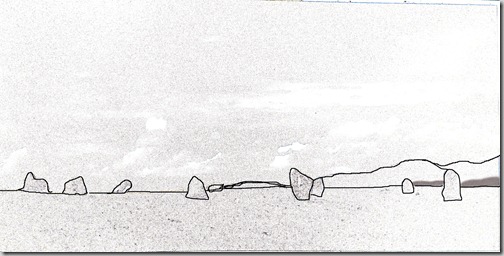
It’s a 2:1 format panorama, with the horizon just below the third – the sky is blue higher up with cumulus clouds above the horizon, and the hills of Ennerdale are just visible on the RHS above a patch of forest. I chose it because I knew of its location and little other reason. It has always struck me as over-emphasising the prettiness of the location, which i drove past nearly every day for 10 years on my way to work. Initially I assumed it was taken from quite close with a reasonable wide-angle lens. I had trouble repeating the composition once I was at the site until I realised that one of the stones in the circle is hidden in the picture behind the stone on the far right. Once I’d established that, it was relatively simple to align the RHS stone with the notch in the hills behind, and the centre groups the same. To my surprise it was taken from a distance of probably 50 yards away with a 35mm equivalent focal length of about 60mm – so essentially a standard lens. Here’s my version:
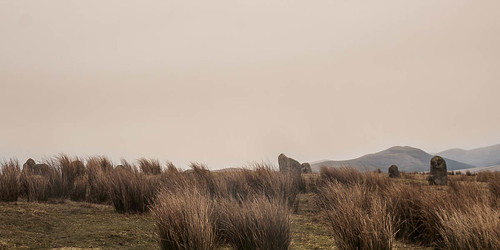
As you can see the joys of a completely flat sky have intruded on the drama, and since the original was taken a considerably quantity of sedges have grown between the camera location and the circle itself. The original in the book looks like it is situated in a lawn. I think the sky is the making of the original, but this is not a viewpoint I would have chosen. In general I prefer to be closer in – for me landscape is as much about detail as it is about vista – and my personal take is here:

This puts more emphasis on the circle and is a truer representation of the surroundings. I tried to reduce the quantity of flat sky and a passing extra cloud and a graduated neutral density filter held in front of the lens to darken the sky somewhat have helped in the respect.
Back in the car and moving on – anyone driving this road needs to concentrate to avoid staring at the magnificent views provided across the west Cumbria coastal plain, which gives me the elevated position I needed for the telephoto exercise. The aim here is to produce a wide variety of shots from a single viewpoint – I’ve perhaps cheated a little as my telephoto zooms from 100-400 in 35mm terms, but since that only represents a cropping option I don’t feel too guilty. All these from the same gate:
There were plenty more options available but this gives a flavour. The three shots of Sellafield show what can be achieved in terms of variety by slight changes in composition or focal length. and the close-ups show that a feel for a landscape can be enhanced, perhaps even conveyed, with more intimate shots as well as expansive views. there are two more shots which I fashioned from this viewpoint – extreme distant views of the wind turbines in Morecambe Bay which feel worth a separate mention simply because I particularly like them. They are essentially different treatments of the same shot – in the larger one of the two I suspect I may be invoking elements of the sublime for the effect
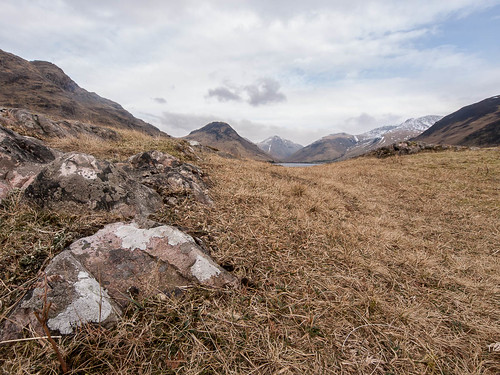
I think the rocks in the foreground provide a helpful visual link to the hills beyond, and I have tried to include enough sky to give an impression of the scale of the scene. And finally – a slightly more humorous take on a very similar scene, using the same technique.
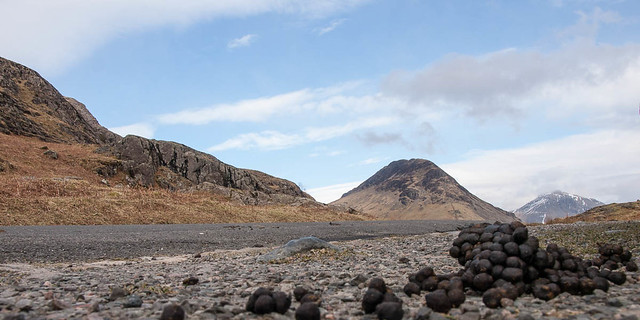
I guess this is unlikely to win any prizes for tourism photography, but it does capture an unavoidable feature of walking in Lakeland valleys.
So far in this course I have resisted resorting to shots of the Lake District, but this trip out has reminded me what I am missing, and also given me the thought that I might use some Lakeland images for the man-made landscape project later in the course and perhaps, in a similar vein since I have R Adams and Hatakeyama on my short list, as a subject for Assignment 5.
My target was Wasdale – to re-photograph a couple of images – via Kinniside Common, which you cross using the fell road from Ennerdale Bridge to Calder Bridge. On the way I planned to stop off at the stone circle on Kinniside Common for another re-photograph. Sadly, by the time I got there the weather had changed it’s mind and I was faced with the featureless sky I feared (three cheers for stratus clouds) but I’ve tried not to let that get in the way.
The photos I’m trying to repeat come from a book called Wainwright in the Valleys of Lakeland, which was his last published book before his death, and is illustrated throughout by photos from a photographer called Derry Brabbs. The first image is of the stone circle on Kinniside Common – I don’t propose to include it, or the others here for copyright reasons, but it is included in my written log and my OneNote archive. To make comparison with my version easier however, here’s a quick sketch of the pertinent bits of the composition:

It’s a 2:1 format panorama, with the horizon just below the third – the sky is blue higher up with cumulus clouds above the horizon, and the hills of Ennerdale are just visible on the RHS above a patch of forest. I chose it because I knew of its location and little other reason. It has always struck me as over-emphasising the prettiness of the location, which i drove past nearly every day for 10 years on my way to work. Initially I assumed it was taken from quite close with a reasonable wide-angle lens. I had trouble repeating the composition once I was at the site until I realised that one of the stones in the circle is hidden in the picture behind the stone on the far right. Once I’d established that, it was relatively simple to align the RHS stone with the notch in the hills behind, and the centre groups the same. To my surprise it was taken from a distance of probably 50 yards away with a 35mm equivalent focal length of about 60mm – so essentially a standard lens. Here’s my version:

As you can see the joys of a completely flat sky have intruded on the drama, and since the original was taken a considerably quantity of sedges have grown between the camera location and the circle itself. The original in the book looks like it is situated in a lawn. I think the sky is the making of the original, but this is not a viewpoint I would have chosen. In general I prefer to be closer in – for me landscape is as much about detail as it is about vista – and my personal take is here:

This puts more emphasis on the circle and is a truer representation of the surroundings. I tried to reduce the quantity of flat sky and a passing extra cloud and a graduated neutral density filter held in front of the lens to darken the sky somewhat have helped in the respect.
Back in the car and moving on – anyone driving this road needs to concentrate to avoid staring at the magnificent views provided across the west Cumbria coastal plain, which gives me the elevated position I needed for the telephoto exercise. The aim here is to produce a wide variety of shots from a single viewpoint – I’ve perhaps cheated a little as my telephoto zooms from 100-400 in 35mm terms, but since that only represents a cropping option I don’t feel too guilty. All these from the same gate:
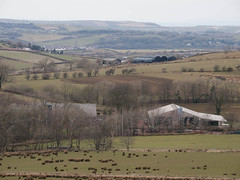 | 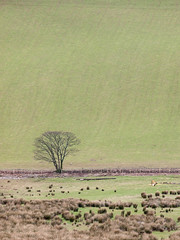 | 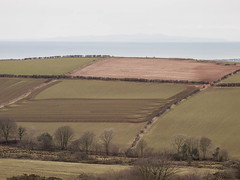 |
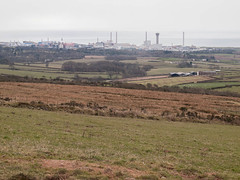 | 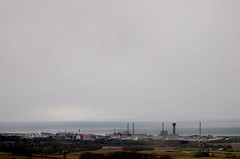 | 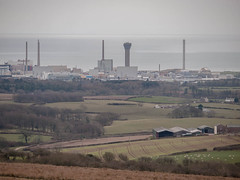 |
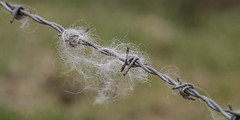 | 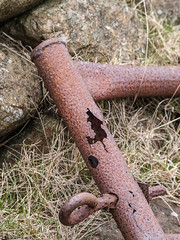 | 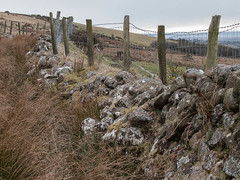 |
Anyway – onwards to Wasdale – an old stomping ground but somewhere I’ve not visited for a while. The next image for re-photographing is a picture of the Wasdale Church and yew trees with a backdrop to Great Gable. This is a classic Lakeland view, which is what attracted me to it as a challenge. A quick sketch and my response as follows:
These are, as near as I can make it, identical. This was much less tricky than the stone circle for the simple reason that the field in the foreground is private, and neatly encircled with dry stone walls, so the shooting position is limited to choosing the location along that wall. The focal length is approx 80mm in 35mm terms. One thing that did cause a little consternation is that the image from the book is laterally reversed – it has been printed backwards! I forgot to take another view from this location, although in truth this is probably the obvious shot. By moving around to the right of the church it may be possible to get a similar angle with Yewbarrow behind, but I didn’t try. I do think the sheep in my shot adds something however.
Homeward bound now, and one more stop for a shot of Wasdale screes. I searched for the best part of half an hour for the location for this shot. I had determined it was likely to be a wide angle shot, but I was convinced it was taken from considerably further away than it actually was. In the end I found the appropriate stand of rocks overlooking the bay in the foreground, and hey presto there it was.
The focal length was 24mm (equiv) and the original was shot around sunset so that the screes themselves are bathed in a warm glow. I have not attempted to re-photograph them myself from this direction for the simple reason that I think this angle fails to capture them as the book describes them:
“…tremendously impressive, a petrified downfall of debris without life or movement..” and “An arid curtain of stone extends far into the distance from the horrendous cliff and gullies…”
To my mind this is definitely not conveyed by the image in the book. I will have to return to attempt a better take, but the sunset lighting softens the cliffs and the wide angle lens reduces them to manageable proportions. I do not believe the feeling of the text can be conveyed within a very short distance of this location. For an alternative then, I cannot address the issues raised in the book, so I have simply turned around and taken a shot up the valley. I have laid down for this shot to make use of the near/far properties of the wide angle.

I think the rocks in the foreground provide a helpful visual link to the hills beyond, and I have tried to include enough sky to give an impression of the scale of the scene. And finally – a slightly more humorous take on a very similar scene, using the same technique.

I guess this is unlikely to win any prizes for tourism photography, but it does capture an unavoidable feature of walking in Lakeland valleys.
So far in this course I have resisted resorting to shots of the Lake District, but this trip out has reminded me what I am missing, and also given me the thought that I might use some Lakeland images for the man-made landscape project later in the course and perhaps, in a similar vein since I have R Adams and Hatakeyama on my short list, as a subject for Assignment 5.
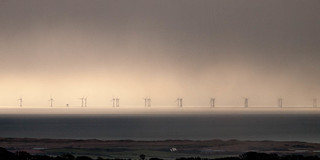

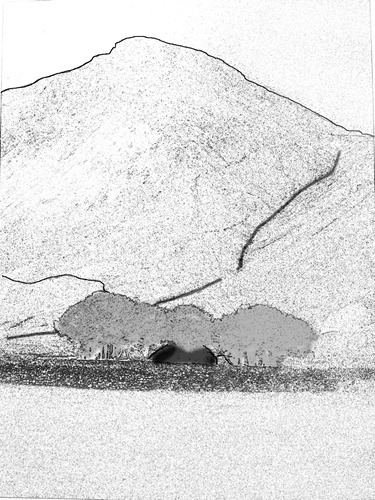

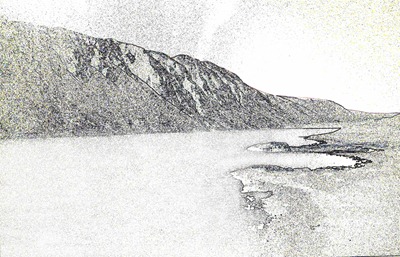

No comments:
Post a Comment